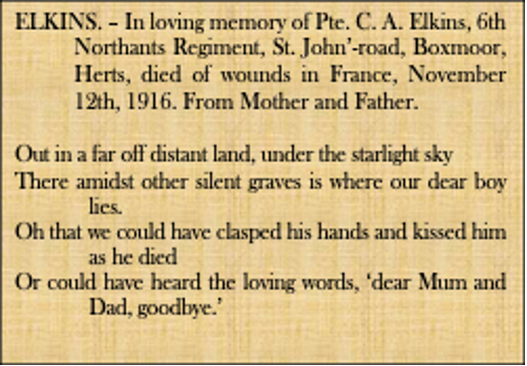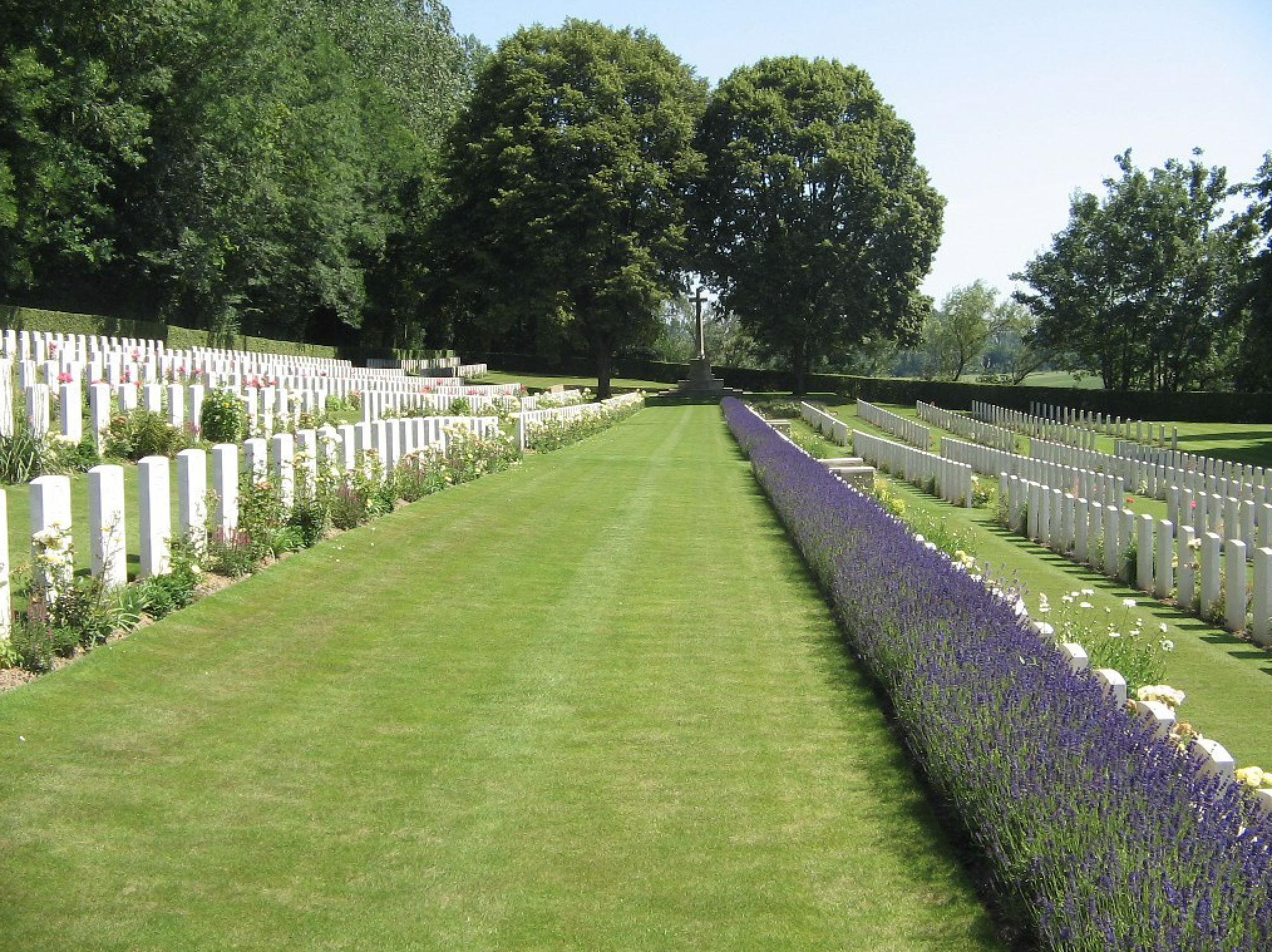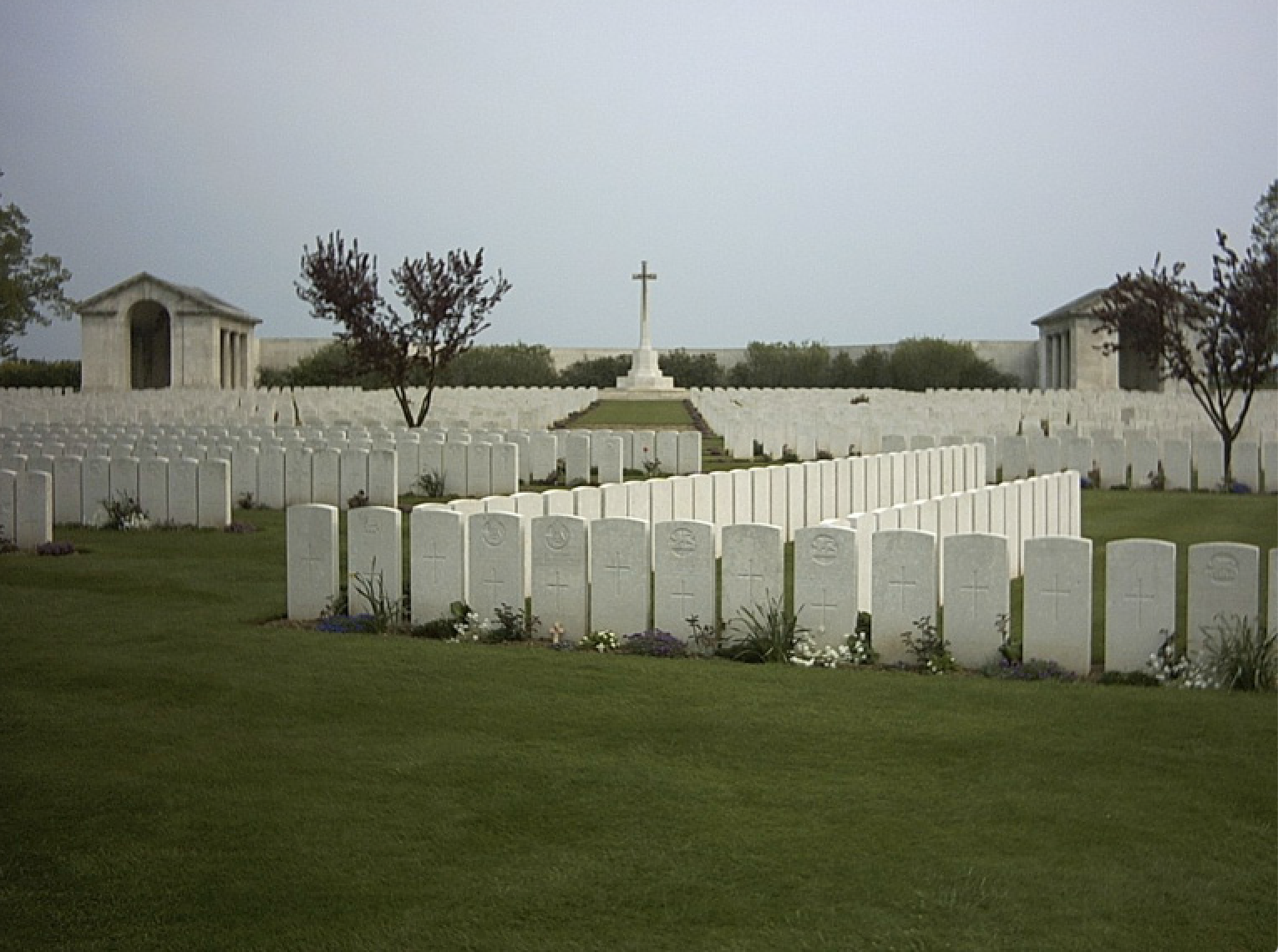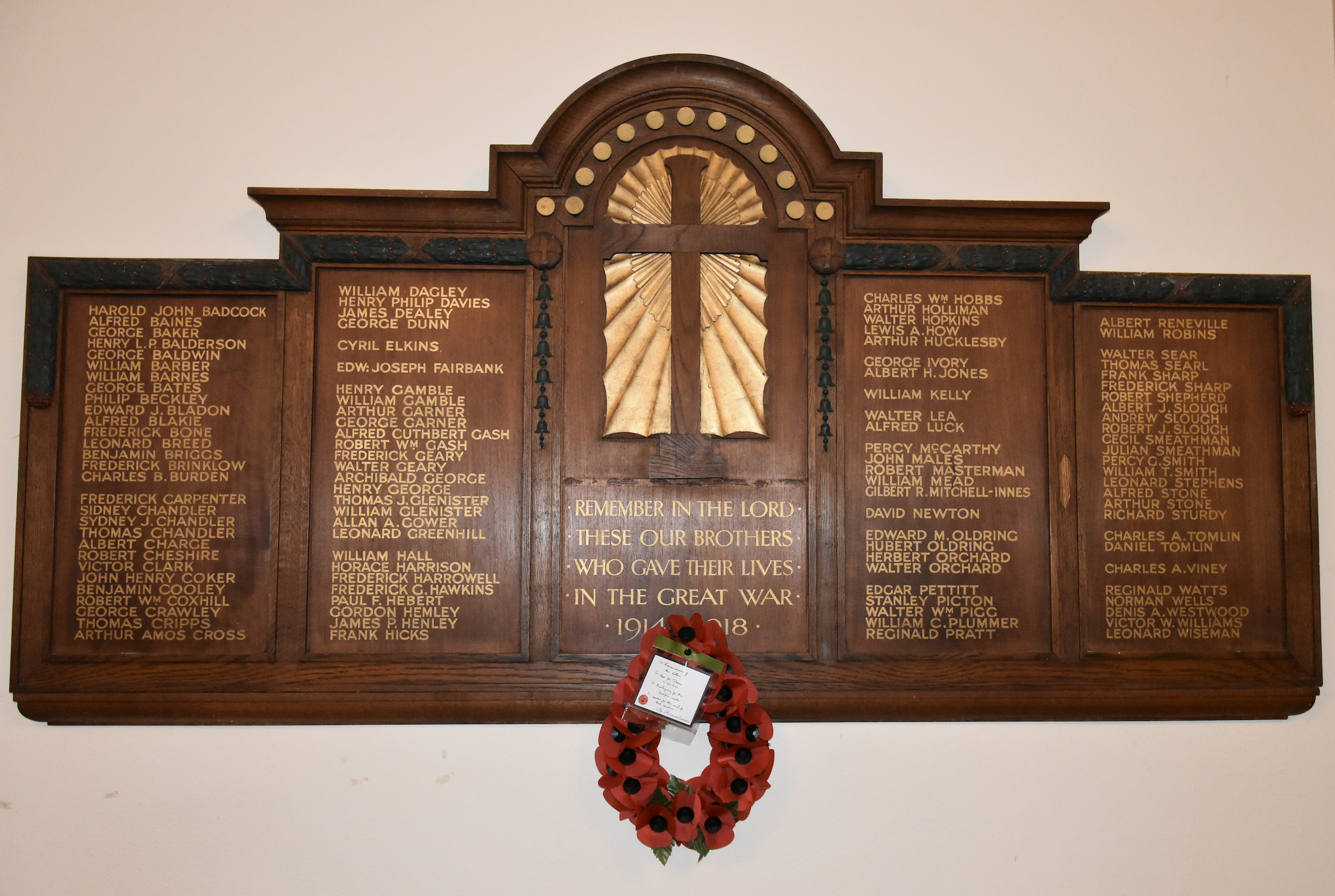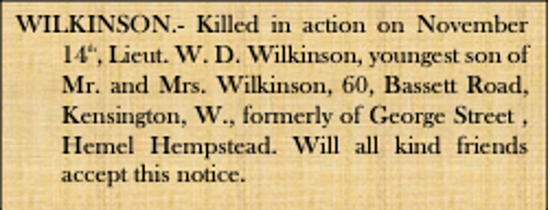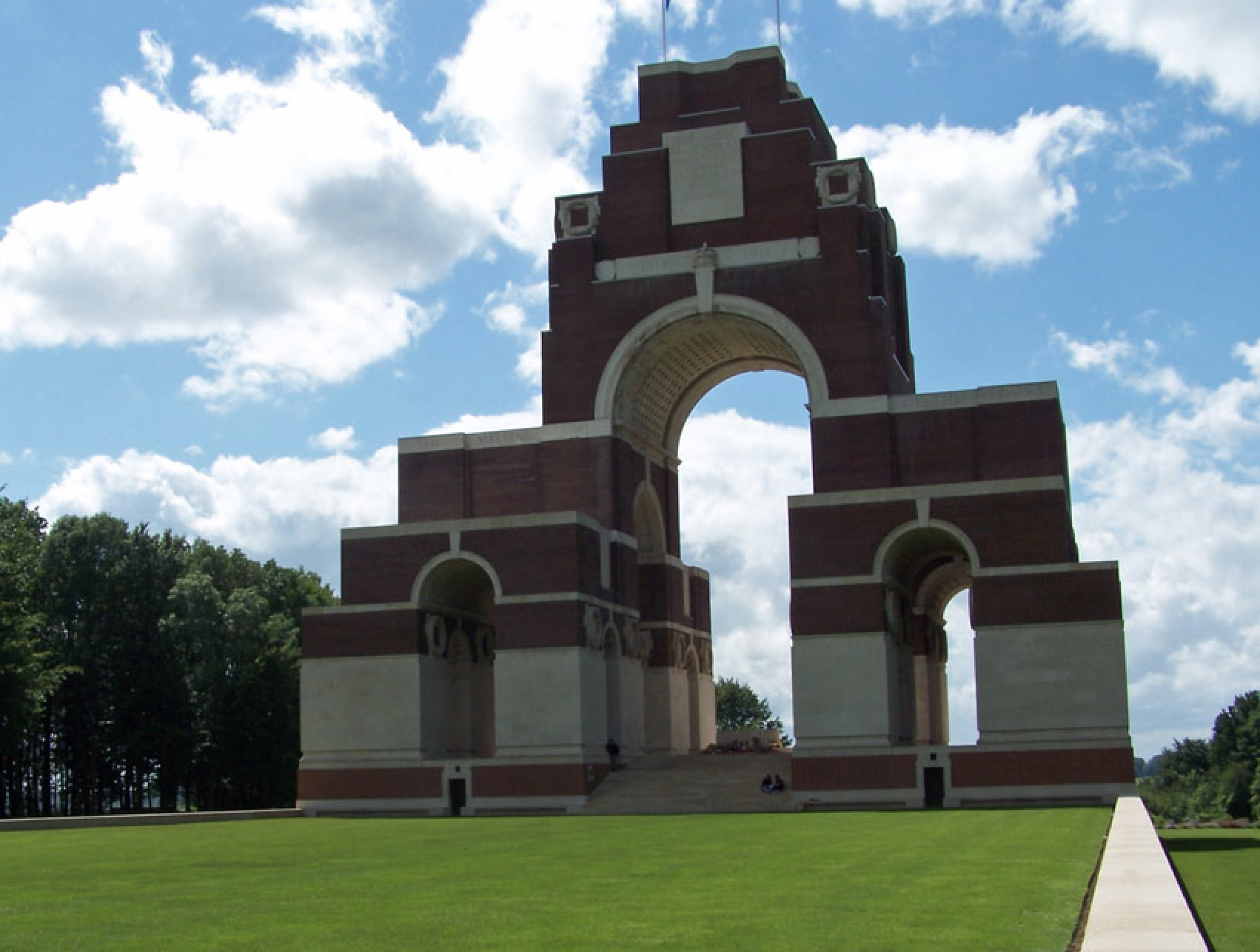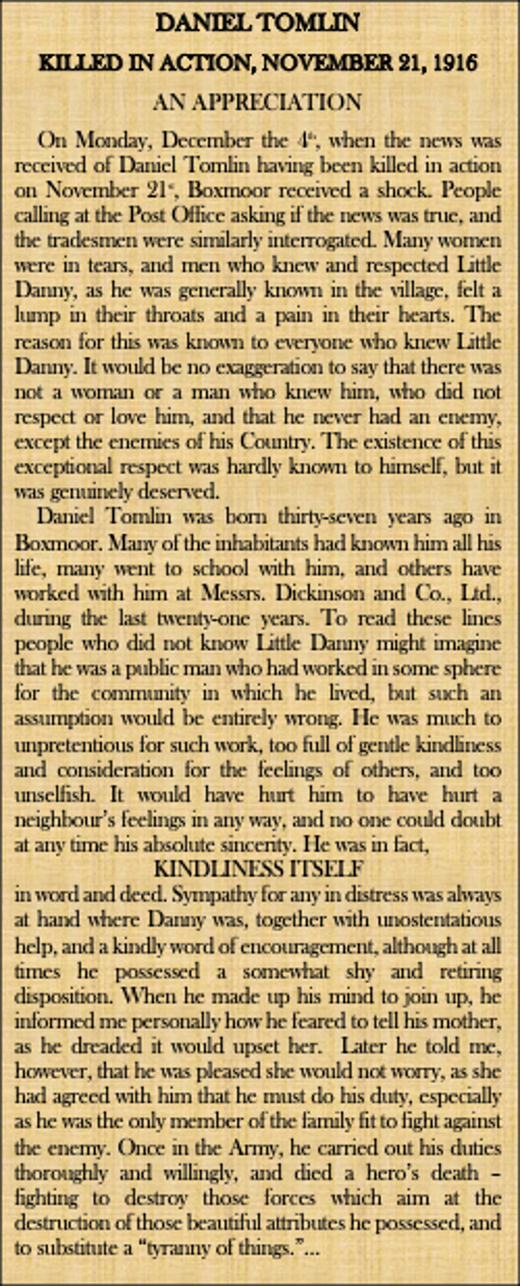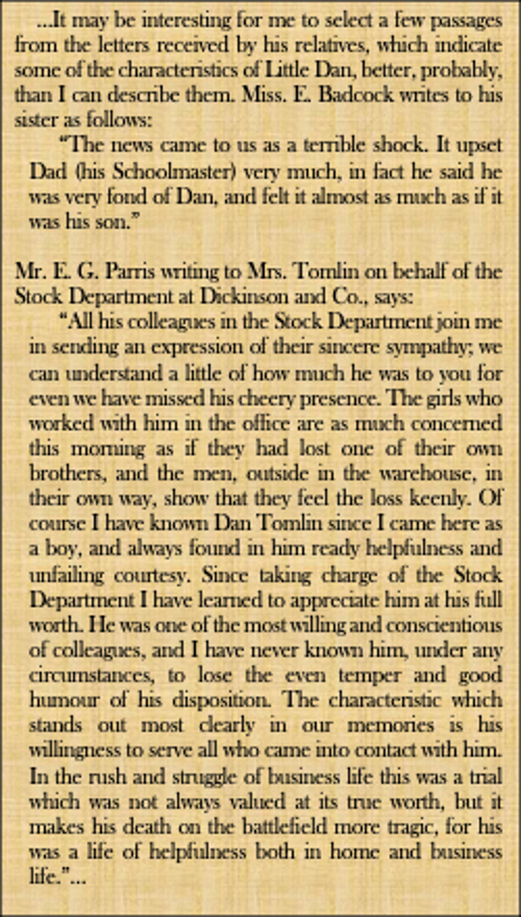Fallen in November 1916:
Cyril Ashley Elkins
Charles Frederick Brinklow
Alfred Frank Luck
Donald Wilkinson
Daniel Tomlin
CYRIL ASHLEY ELKINS
43071 Private
6th Bn., Northamptonshire Regiment
Died of Wounds Sunday, 12th November 1916
Remembered with Honour, Contay British Cemetery, Contay, Somme, France, Grave IV. D. 6.
Cyril Ashley Elkins was born in Boxmoor, Hertfordshire on Wednesday, 27th February 1895 and baptised in St John’s church in the village two months later on Sunday, 21st April. He was the only son born to Walter Elkins and his second wife Helen Eliza Gurney. Cyril had an older half brother Bertie Stephen who was his father’s son from his first marriage to Charlotte Jane Newans who had died in 1892.
In 1901 Cyril lived with his family in St John’s Road in Boxmoor and his father Walter worked as a ‘Plumber’. Cyril started at Boxmoor JMI School in 1901 and achieved two of his ‘Standards’ by the time he left in March 1908 "To help his mother in a grocer’s shop", one of at least six grocers on St John’s Road at that time.
By 1911 when he was sixteen-years-old, Cyril had found new employment and worked as a ‘Servant’ in nearby Heath Brow School on Heath Lane. This was a small private school which occupied a house called ‘Hillside’, previously a private residence, which stood opposite the Hemel Hempstead School playing fields today.
Cyril enlisted to fight under the ‘Derby Scheme’ which was launched in the autumn of 1915 by the Earl of Derby, who was Kitchener's new Director General of Recruiting. The scheme was intended to determine whether British manpower goals could be met by volunteers or if conscription was necessary.
Each eligible man aged eighteen to forty-one who was not in a "starred" (essential) occupation had to make a public declaration. When the scheme was announced there was a surge in recruiting because many men volunteered without waiting to be "fetched". By the end of December over 318,000 fit single men had been identified but some 121,000 of these men publicly refused to enlist which was a factor leading to the introduction of conscription early in 1916.
Cyril attested at Hemel Hempstead in December 1915 and enlisted with the Northamptonshire Regiment and was posted to the 6th Battalion. It is not clear when Cyril went to France, but it seems likely that he would have embarked after approximately six months basic training. This would put his arrival with the Battalion at around May or June of 1916 and the Battalion War diary mentions two drafts of men joining on the 26th May so it is possible that these drafts included Cyril. If so, he was soon in action on the Somme as the 6th Battalion fought in the Battles of Albert, Bazentin, Delville Wood, Thiepval Ridge, Ancre Heights and in the final attack at the Somme in the Battle of Ancre.
It appears that Cyril was wounded in fighting between the 6th and 10th November on the Mouquet Road between Thiepval and Pozieres as the Battalion War Diary records a number of casualties on each of those days. What is known is that Cyril would have been taken to a nearby Dressing Station for initial treatment before evacuating to No.9 Casualty Clearing Station at Contay approximately twelve miles to the west.
It was here that Cyril died from his wounds on Sunday, 12th November 1916
A year after his death his parents posted an "In Memoriam" notice in the Hemel Gazette which included a moving verse describing their forlorn grief at the loss of their son. (see extract)
He was commemorated on a memorial plaque in St John’s Church in Boxmoor.
Cyril is Remembered with Honour in Contay British Cemetery, Contay, Somme, France where he is interred in Grave IV. D. 6.
He was 21 years old when he died.
Cyril was entitled to the British War Medal and the Allied Victory Medal.
‘Hillside’ – Heath Brow School where Cyril worked in 1911 (Courtesy:http://www.dacorumheritage.org.uk)
Extract from The Hertfordshire, Hemel Hempstead Gazette and West Herts Advertiser 10th Nov. 1917
Memorial Plaque – St John the Evangelist Church, Boxmoor (Courtesy: Traquair Photography 23rd Mar. 2019)
Contay British Cemetery, Contay, Somme, France (Courtesy: CWGC)
CHARLES FREDERICK BRINKLOW
35021 Private
24th Bn., Royal Fusiliers
Killed in Action Monday, 13th November 1916
Remembered with Honour, Serre Road Cemetery No.2, Somme, France, Grave I. B. 30.
Charles Frederick Brinklow was born in the Spring of 1891 in Hemel Hempstead, the oldest child of Frederick Arthur Brinklow and Emily Ghost. Frederick and Emily had nine children together who were: Charles Frederick, Herbert Thomas, Edith Alice, Herbert Arthur, William Percy, Nellie Beatrice, Sybil Dorothy Marjory, Hilda Emily and the youngest Edward Richard.
The youngest boy Edward was born only two years before Charles was killed. Herbert Thomas died in 1894 aged one and Charles’ brother Herbert Arthur served with the 6th Northamptonshire Regiment in the Great War. He was wounded in July 1918 but survived the conflict.
When Frederick Snr. and Emily married, their ‘Best man’ and ‘Bridesmaid’ were William Leonard Ansell and Mary Ann Carrington, the step-father and mother of William George Carrington, another young Hemel soldier who was killed in the Great War and who appears on the Hemel Hempstead War Memorial twice. Once as William Carrington and once as William Ansell. William’s biography also appears on this site.
By 1901 the Brinklow family had moved to Sunnyhill Road in Hammerfield between Crouchfield and Hemel Hempstead where they lived in well into the 1920s.
By the time he was twenty-years-old in 1911, Charles had started work as a ‘General Labourer’, however, he moved to Nash Mills to work for John Dickinson & Co. Limited before the start of the War. It was while working in Nash Mills that he met Mary Ann Horne, an ‘Envelop Maker’ from Tring and they married in the Summer of 1915 in Hemel Hempstead.
The date of Charles’ enlistment is not known but it seems he may have joined in March 1916 under the provisions of the Military Service Act and before the married man’s exemption was lifted in May of that year. Nevertheless, he attested at Watford and joined the 24th (Service) Battalion Royal Fusiliers (2nd Sportsman’s), a battalion of the City of London Regiment.
The 'Sportsman's' battalions were among the ‘Pals’ battalions formed by the British Army in the early stages of the First World War. However, rather than young men from a small geographical area, these particular battalions were largely made up of men who had made their name in sports such as cricket, golf, boxing and football or the media. The 24th (Service) Battalion Royal Fusiliers (2nd Sportsman’s) was one of two battalions raised in London by Mrs. Emma Cunliffe-Owen.
She was challenged by a group of men friends to raise a battalion after she had questioned why they had not enlisted, so she telegrammed Lord Kitchener to ask: “Will you accept complete battalion of middle- and upper-class men, physically fit, able to shoot and ride, up to the age of 45?” He promptly accepted her offer and Emma immediately advertised in The Times as follows: “Sportsmen, aged 19 to 45, upper and middle class only. Wanted at Once. Entrance fee 3 guineas, or kit. No other financial obligations. Head Recruiting Office, E. Cunliffe-Owen, Hotel Cecil, London. Hours 10 a.m. to 6 p.m. daily”
Within four weeks she had raised her first battalion and even paid for a training camp to be built in Hornchurch, Essex to prepare the men for war. Despite the advert stipulating “upper and middle classes only”, the mixture of recruits was extraordinary. It was described by Fred Ward, a captain in the 24th, who after the war created a history of the battalions.
“It was cosmopolitan, practically every grade of life was represented, from the peer to the peasant; class distinctions were swept away, every man turned to and pulled his bit. In this hut [of 30 men at Hornchurch] the first bed was occupied by the brother of a peer. The second by the man who formerly drove his motor-car. Other beds were occupied by a mechanical engineer, an old Blundell School boy, planters, a mine overseer from Scotland, a man in possession of a flying pilot's certificate secured in France, a photographer, a poultry farmer, an old sea dog who had rounded Cape Horn on no fewer than nine occasions, a man who had hunted seals ‘with more patches on his trousers than he could count’, a bank clerk, and so on.”
There were also sports stars of past and present; England cricketers, league footballers, boxers, a top golfer, rugby players, an Olympic archery champion, rowers, a Wimbledon umpire and athletes. The definition of a “sportsman” was wide-ranging; the battalion took in explorers and adventurers, big game hunters, old soldiers, lawyers, council officials, gamekeepers, builders and tradesmen, a former mayor of Exeter, stockbrokers, a baronet, scholars, artists, shopkeepers, gamblers, actors and comedians, teachers and journalists. Anyone, in essence, who was a good sport.
One of the most famous recruits was aged sixty-four; Frederick Courteney Selous, big game hunter, conservationist, explorer, inspiration for the King Solomon’s Mines stories and friend of US President Teddy Roosevelt. He won the DSO and was killed fighting German forces in East Africa with the 25th “Frontiersmen” Battalion of the Fusiliers.
Charles undertook his basic training at Hare Hall, Romford in Essex and on the 26th July 1916, he went to France to join his Regiment as part of the 5th Brigade in the 2nd Division. The 24th had been fighting at the Somme near Montaubin when Charles arrived at the end of July and he was soon in the trenches during the next two months. His first significant action came at the Battle of Ancre in November.
Pte. Charles Brinklow c1915 (Courtesy: The Hertfordshire, Hemel Hempstead Gazette and West Herts Advertiser)
The formidable Mrs. Emma Cunliffe-Owen in 1914 (Courtesy:http://inspirationalwomenofww1.blogspot.com)
John Dickinson & Co. Limited War Memorial, Apsley End (Courtesy: Traquair Photography 28th Aug. 2016)
Serre Cemetery No.2, Somme, France (Courtesy: CWGC)
The 24th Battalion attacked the German lines on the morning of the 13th November and during the fighting suffered significant casualties, some as a result of the moving barrage from its own artillery. However, it achieved its objectives and captured the enemy trenches. The casualties on that day were as follows: "Officers, 13 killed, missing or wounded. O.R., 191 killed or wounded; 50 missing."
Charles was one of the men listed ‘missing’ following the attack and he was subsequently confirmed dead. He was Killed in Action on Monday, 13th November 1916. He had been at the front for just over three months when he died.
He was commemorated on the John Dickinson & Co. Limited War Memorial in Apsley.
Charles is Remembered with Honour in the Serre Road Cemetery No.2, Somme, France where he is interred in Grave I. B. 30. The inscription on his headstone, requested by his wife Mary Ann, reads: ”HE GIVETH TO HIS BELOVED SLEEP PEACE PERFECT PEACE”
He was 25 years old when he died.
Charles was entitled to the British War Medal and the Allied Victory Medal.
ALFRED FRANK LUCK
266764 Private
1st Bn., Hertfordshire Regiment
Killed in Action Monday, 13th November 1916
Remembered with Honour, Thiepval Memorial, Somme, France, Pier and Face 12C
Alfred Frank Luck was born in Camden, Middlesex in March 1886 to Alfred and Sarah Luck. Alfred and Sarah had five children of whom three are known: Alfred, Edith May and Florence. The other two children died in infancy.
His sister Edith married Frederick Room from Dunstable who was also killed in the war in 1918. Frederick’s biography also appears on this site.
When Alfred was born his family where living in Camden in London where his father worked as a ‘Clerk’ for the Midland Railway. By 1891 his father’s job took the family to Harpenden where Alfred’s parents had originally lived.
By 1901 Alfred and his father were both employed by Abbott, Anderson & Abbott Ltd, manufacturers of oilskins and rubber goods at the Heathfield Works in Harpenden. Alfred worked as a ‘Stopper Counter’ whilst his father was a ‘Store Keeper’.
By 1903, the Luck family had moved to Boxmoor near Hemel Hempstead and lived at 6 Two Waters Road in the village. Alfred had found new employment and worked for Baldersons as a ‘General Labourer’ and no doubt to enhance his wages, he decided to join the Militia. In December of the same year he enlisted with the 4th Bedfordshire Regiment but his service was short-lived. On the 30th January 1904 he was discharged for “having made a misstatement as to age on enlistment”. He had attested claiming to be seventeen years and ten months old when in fact he was sixteen years and ten months, too young to enlist.
After he left the Militia, Alfred met Annie Maple from Wilstone, Tring and they married in Hemel Hempstead in the late Spring of 1907. They had three children together; Alfred Charles, Violet May and Ernest Frank and by 1911 they were lodging with the Carter family in Hammerfield between Crouchfield and Hemel Hempstead.
By this time Alfred worked for James Major Picton, a ‘Boot Maker’ by trade but, when Alfred joined the Colours, Picton was landlord of the Steam Coach pub on St John’s Road in Boxmoor having taken it over from his mother Lydia, who had in turn had taken over management of the pub from her late husband Daniel.
Alfred enlisted in 1915 attesting at Hemel Hempstead in June and joining the Hertfordshire Regiment. When his basic training was completed he was posted to the 1/1st Battalion known as the “Hertfordshire Guards”. He was sent to France at the beginning of 1916 and joined his Battalion at Ham-en-Artois. He was with the 1/1st Battalion when, in February, it transferred to the 118th Brigade in the 39th Division, which comprised: 1/1st Hertfordshires, the 1/1st Battalion Cambridgeshire Regiment, the 1/6th Battalion Cheshire Regiment and finally the 4/5th Battalion Black Watch - amalgamated with the 1/4th and 1/5th Battalions.
Alfred fought in a number of engagements throughout 1916 but saw his most significant action at the Battle of Ancre in November. The Battalion War Diaries recorded the events as follows: "12 and 13-11-16. In the evening the battalion left billets and marched in light fighting order to the SCHWABEN REDOUBT where it formed up in assembly positions in four lines. At 5.45am on the 13th just before dawn and in a thick mist the guns opened fire, the Bn went forward, the Cambridgeshires on the left and the East Lancs (19th Division) on the right. Direction was kept and the Bn had very soon taken all its objectives, capturing the whole of the HANSA line and advancing to a depth of 1,600 yards. Over 250 prisoners were captured and many Germans were killed. The new line was consolidated and the Bn held the new position till the night of the 14th/15th. During the period the Germans made three small raids against the bombing post on our left but these were successfully driven back. In all these operations 9 machine guns were captured. The Bn was relieved on the night of 14th/15th by the Kings Own and marched back to huts near AVELUY, its last platoon leaving the trenches at 5.0am. During the period our casualties were; 7 Officers wounded, 20 OR killed, 5 OR missing, and 115 OR wounded."
Alfred was one of the twenty O.R. killed during the attack and he died on Monday, 13th November 1916.
His death was reported, shortly after he was killed, in the Hemel Gazette which published a letter that his wife had received from his C.O. 2nd Lieutenant Eric Smallwood. (see extract)
Alfred was commemorated on a memorial plaque in St John’s Church in Boxmoor.
Alfred is Remembered with Honour on the Thiepval Memorial, Somme, France, Pier and Face 12C
He was 30 years old when he died.
Alfred was entitled to the British War Medal and the Allied Victory Medal.
Pte. Alfred Luck c1915 (Courtesy: The Hertfordshire, Hemel Hempstead Gazette and West Herts Advertiser)
Abbott, Anderson & Abbott Ltd Heathfield Works where Alfred worked in 1901 (Courtesy:http://www.harpenden-history.org.uk)
Extract from The Hertfordshire, Hemel Hempstead Gazette and West Herts Advertiser 9th Dec. 1916
Memorial Plaque – St John the Evangelist Church, Boxmoor (Courtesy: Traquair Photography 23rd Mar. 2019)
Thiepval Memorial, Somme, France (Courtesy: CWGC)
WILLIAM DONALD WILKINSON
2nd Lieutenant
5th Bn., Essex Regiment
Killed in Action Monday, 14th November 1916
Remembered with Honour, Thiepval Memorial, Somme, France, Pier and Face 10 D
William Donald Wilkinson, known as Donald, was born at 82 Inderwick Road, in Hornsey, Middlesex on Wednesday, 30th September 1896, the youngest son of Frederick John Wilkinson and Anne Coleman who had eight children together. There were five boys and four girls; Archibald Harrap, Constance Attwater Felix Wilfred, Frederick Edward, Ernest (Alec) Alexander, Margaret Stella, William Donald and Kathleen Grace. Three of Donald’s brothers served in the Great War; Frederick and Felix fought with the Canadian Army and survived the conflict. His brother Alec however, was killed in France in 1915 and his biography appears on this site.
Donald’s father Frederick was a Clerk to the Church Missionary Society (CMS). The CMS was founded in 1799 and was committed to three great enterprises: abolition of the slave trade, social reform at home and world evangelisation. William Wilberforce MP was among the founding members. Frederick’s job meant the family had moved frequently as the children were growing up before he finally settled near Croydon in Surrey.
In 1901 when Donald was four years old, the family were living at St Mary’s in Elstree, Hertfordshire and all the children, except for Constance, Donald and Kathleen were at school or university. Donald went with his brother Alec to The Skinner’s School in Royal Tunbridge Wells in 1906 when he was ten years old.
He spent seven years at Skinner’s but still had time to participate as a member of Hemel Hempstead Swimming Club when he was at home for holidays. He was an accomplished sportsman playing for the School 1st XI at football and cricket and after being Games Secretary in 1911, he was made School Captain.
Academically gifted, he left Skinners in 1913 with a Hunt and Atwell Exhibition (University Scholarship), the top scholarship award from the School and worth £35 per year for three years. He was a clever and useful actor in school plays and a contributor to "The Leopard" the Skinner’s magazine.
Donald was a Sergeant in the Officers’ Training Corps (OTC). The School's Cadet Corps was created in 1900 and when war broke out in 1914, a high proportion of these cadets joined the army as junior officers. By the end of the war 522 Skinners' School Masters and Old Boys had served in the Armed Forces (roughly 40% of the 1200 boys who had attended the school since its foundation in 1886). Of these eighty-nine are commemorated on the Memorial at the back of the Old School Hall having paid the ultimate sacrifice whilst serving their country.
Donald enlisted in the 28th London Regiment (2nd Artist’s Rifles) attesting at Dukes Road, London on the 5th October 1915 five days after his nineteenth birthday and when he was eligible to serve overseas. Soon afterwards, on the 24th January 1916, he was recommended for a commission with the 3/5th Battalion Essex Regiment and took this up when he was posted five months later and went to France on the 3rd June.
Despite being commissioned with the 5th Battalion it appears that Donald served in France with the 1st Battalion Essex Regiment which fought at the Battle of the Somme. He saw significant action at the Battle of Transloy and the Battle of Ancre and it was in the latter that he met his end whilst leading his platoon into the German trenches.
Donald was Killed-in-Action on Monday, 14th November 1916.
His death was notified in the Hemel Gazette shortly afterwards. (see extract)
The Skinner’s School, Royal Tunbridge Wells, Kent (Courtesy: https://theweald.org)
Extract from The Hertfordshire, Hemel Hempstead Gazette and West Herts Advertiser 25th Nov. 1916
Skinner's School War Memorial (Courtesy: https://www.tracesofwar.com) (Photo: © Susan Featherstone (WMR-68148)
Thiepval Memorial, Somme, France (Courtesy: CWGC)
He is commemorated at The Skinner’s School in a memorial book along with his brother Alec and on the memorial plaque in the school.
Donald is Remembered with Honour on the Thiepval Memorial, Somme, France, Pier and Face 10D
He was only 20 years old when he died.
Donald was entitled to the British War Medal and the Allied Victory Medal.
DANIEL TOMLIN
29527 Private
23rd Bn., Middlesex Regiment
Killed in Action Tuesday, 21st November 1916
Remembered with Honour, Voormezeele Enclosure No.3, West-Vlaanderen, Belgium, Grave XII.B.8.
Daniel Tomlin, known as Danny or ‘Little’ Danny was born in Boxmoor, Hertfordshire on Friday, 17th January 1879 and baptised at St John’s Church in the village eight months later, on Wednesday, 10th September. He was the youngest of five children born to Frederick Thomas Tomlin and Elizabeth Walker. The children were Emma Jane, Frederick Thomas, Fanny Elizabeth and Daniel as well as two unknown children who died in infancy.
When he was born, Danny’s father Frederick was suffering from consumption and he died in 1881 when Danny was only two-years-old.
Daniel Tomlin c1915 (Courtesy: The Hertfordshire, Hemel Hempstead Gazette and West Herts Advertiser)
Little Danny began his education in March 1885 when he entered Boxmoor JMI school, where he successfully completed all seven ‘standards’ by the time he left on the 5th March 1892 aged thirteen. Three years later, he started work with John Dickinson & Co. Limited where he worked for twenty-one years as a Clerk in the Stock Department.
By 1901 Danny was living with his mother on Horsecroft Road, Boxmoor and he continued to live with her until in late 1915 he joined the Colours. He enlisted with the Duke of Cambridge's Own (Middlesex) Regiment and was posted to the 23rd (Service) Battalion (2nd Football) at Cranleigh south of Aldershot to undergo basic training.
There were two ‘Football’ battalions in the Great War; the 17th and 23rd (Service) Battalions Middlesex Regiment and as their name suggests, the core of recruits came from the ranks of professional football. Needless to say, the Battalions fared well in inter-company competitions and over the first months of 1916 the 17th won the Divisional Football tournament, romping through the rounds with victories of 9-0, 6-0 and 6-0 in the semi-final, before winning 11-0 in the final, against 3/4 Brigade Royal Field Artillery.
Their ranks contained such footballing legends as Viv (Vivian) Woodward of Spurs and Chelsea who captained the GB team to Olympic golds in 1908 and 1912 and 2nd Lieutenant Walter Tull, thought to be the first black officer in the British Army, who was killed in action in March 1918.
Danny went to France with the 2nd Footballers in the first week of May 1916 as part of the 123rd Brigade under the orders of the 41st Division. The Battalion concentrated between Hazebrouck and Bailleul before moving south where it saw its first significant action.
Danny fought in the Battle of Flers-Courcelette in September 1916 and the Battle of Transloy Ridges in the following month and came through unscathed.
The Battle of Transloy was the last major offensive for the Fourth Army of the BEF on the Somme. At its conclusion, the 23rd Middlesex entrained for Godewaersvealde on the French/Belgian border on October 19th, 1916. A few days later Danny had marched with his comrades to Reninghelst about six miles west of Ypres.
Over the next month the Battalion served tours in the frontline trenches until on the 21st October the War Diary records the following events: “CENTRE BATTN. SUBSECTOR ST. ELOI [sic] 21st 2.15a.m. Zero. Artillery make a dummy raid. Concentrated fire for twenty minutes along craters and left of our line. On our front enemy makes next response; his machine guns fire about 20 rounds. Draft 4 OR 1 OR Killed”
This brief entry describes the sad end to Danny’s war as he was the OR killed by the brief burst of enemy fire. He was Killed in Action on Tuesday, 21st November 1916.
Danny’s death at the Front was greeted with disbelief and genuine grief at home in Boxmoor and even before his mother had received official confirmation, one of his friends, Thomas G. Hollands McCarthy felt moved to write an appreciation of ‘Little’ Danny’s life which was published in the Hemel Gazette. It is clear from the piece just how popular Danny was and the respect and esteem he was held in by all who knew him in the village, at Dickinsons and amongst his Company comrades in the 23rd Middlesex.
He was described as “unpretentious” and “full of gentle kindliness and considerations for the feelings of others” indeed he was depicted as “KINDLINESS ITSELF”. His old Headmaster at Boxmoor JMI School felt his loss keenly and his daughter said, “almost as much as if it was his son”. Francis St. John Badcock had already lost his youngest son Harold who was killed only four days before Danny.
Daniel Tomlin c1915 (Courtesy: The Hertfordshire, Hemel Hempstead Gazette and West Herts Advertiser)
Extract from The Hertfordshire, Hemel Hempstead Gazette and West Herts Advertiser 16th Dec. 1916
Extract from The Hertfordshire, Hempstead Gazette and West Herts Advertiser 2nd Jan. 1917
John Dickinson & Co. Limited War Memorial, Apsley (Courtesy: Traquair Photography 28th Aug. 2016)
Voormezeele Enclosure No.3, West-Vlaanderen, Belgium (Courtesy: CWGC)
The Gazette piece is included in full in this biography. (see extract)
His mother Elizabeth received official confirmation of Danny’s death two days before Christmas on the 23rd December 1916. (see extract)
He is commemorated on the John Dickinson & Co. Limited War Memorial in Apsley.
Danny is Remembered with Honour in Voormezeele Enclosure No.3 Cemetery, West-Vlaanderen, Belgium, where he is interred in Grave XII.B.8. The inscription on his headstone, requested by his mother Elizabeth, reads: “IN GOD'S KEEPING”.
He was 37 years old when he died.
Danny was entitled to the British War Medal and the Allied Victory Medal.
